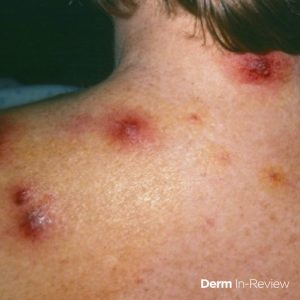
The correct answer is E. Superficial dermal edema with dense neutrophilic infiltrate
The clinical presentation most likely represents Sweet syndrome (acute febrile neutrophilic dermatosis). Classical Sweet syndrome is frequently associated with recent infections, IBD and pregnancy. Diagnosis is made with two major and two minor criteria:
Major criteria:
1. Abrupt onset of painful erythematous plaques
2. Histopathological evidence of a dense neutrophilic infiltrate without evidence of leukocytoclastic vasculitis
Minor criteria:
1. Fever
2. Association with malignancy, inflammatory disease, pregnancy or recent URI, GI infection, vaccination
3. Excellent response to systemic steroids
4. Abnormal lab values (ESR, CRP, leukocytosis, >70% neutrophils)
Incorrect: Option A represents leukocytoclastic vasculitis. Option B represents erythema multiforme. Option C is the pathology for neutrophilic eccrine hidradenitis. Option D represents leukemia cutis.
Reference:
Nelson CA, Stephen S, Ashchyan HJ, et al. Neutrophilic dermatoses: Pathogenesis, Sweet syndrome, neutrophilic eccrine hidradenitis, and Behçet disease. J Am Acad Dermatol. 2018 Dec;79(6):987-1006. [https://www.ncbi.nlm.nih.gov/pubmed/29653210]
